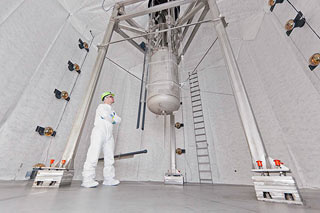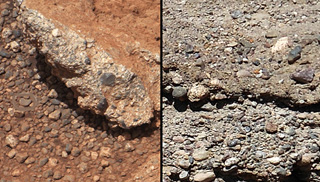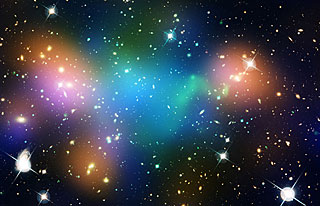The Press Room highlights computational astronomy work around the UC-HiPACC consortium; the wording of the short summaries on this page is based on wording in the individual releases or on the summaries on the press release page of the original source. Press releases below appear in reverse chronological order (most recent first); they can also be displayed by UC campus or DOE lab by clicking on the desired venue at the bottom of the left-hand column.
August 4, 2014 — Funds awarded to begin construction of Large Synoptic Survey Telescope

The 8.4-meter LSST will use a special three-mirror design, creating an exceptionally wide field of view. Credit: LSST/rendering
October 30, 2013 — First results from LUX dark matter detector rule out some candidates

A mile underground, graduate student Jeremy Mock examines the xenon tank at the heart of the LUX dark matter detector.
view full UCD Press Release
May 30, 2013 — Ancient streambed found on surface of Mars (WITH VIDEO)

These two images compare the outcrop of rocks on Mars (left) with similar rocks seen on Earth.
view full UCI Press Release
May 16, 2012 — Science Underground: Going to Great Depths

The tunnel on the left is the entrance to the cavern that will house the MAJORANA DEMONSTRATOR neutrino experiment and also provides access to the LUX experiment, which is searching for particles of dark matter. The tunnel to the right is a separate entrance to the cavern in which Ray Davis performed his famous neutrino experiment, now modified to house LUX. (Photo Matt Kapust)
The Davis Campus of the Sanford Underground Research Facility -- the Halls of Ivy it’s not.
The word “campus” brings to mind neo-Gothic bell towers and green lawns, not tunnels and caverns almost a mile underground. But that’s what the Davis Campus at the Sanford Underground Research Facility looks like, 4,850 feet down in the Homestake Mine in the Black Hills of South Dakota. Although SURF has weathered a series of funding ups and downs worthy of the rise and fall of the elevator cages that once took miners, and now scientists, to work in the mine, last year the U.S. Department of Energy successfully assumed sponsorship of the Sanford Lab’s scientific program from the National Science Foundation. DOE will maintain the mine as a home for existing and proposed projects to investigate dark matter, the secrets of the elusive neutrino, and other research that can only be done deep down in the dark...
view full LBL feature
March 2, 2012 — Dark matter's odd behavior baffles astronomers

In this false color image of merging galaxy cluster Abell 520, the clump of green and blue in the center shows that, unexpectedly, most of the dark matter has remained in the middle of the collision instead of passing through with the galaxies. (NASA/photo)
New results from NASA's Hubble Space Telescope confirm that, contrary to predictions, dark matter -- the invisible substance that makes up much of our universe -- and galaxies parted ways in the collision of two galaxy clusters 2.4 billion light-years away. Now, astronomers are left trying to explain dark matter's seemingly oddball behavior in the Abell 520 merging galaxy cluster...
January 18, 2012 — Faint 'satellite galaxy' discovered

The image of a distant galaxy (blue) is lensed into a ring shape by the gravity of a galaxy closer to Earth (yellow). By looking at the image of the background galaxy, astronomers detected the presence of a faint satellite galaxy around the lens galaxy. (Chris Fassnacht/UC Davis graphic)
The find, described in a paper published online today (Jan. 18) in the journal Nature, could help astronomers find similar objects and confirm or reject theories about the structure of the cosmos...
January 10, 2012 — When galaxy clusters collide

This image of merging galaxy clusters taken with the Hubble Space Telescope shows that the "North" and "South" clusters have passed through each other. Blue coloring shows dark matter, and red shows gas clouds which have collided in the middle. (William Dawson, UC Davis graphic)
“A galaxy cluster is like a little universe, because it has the same matter composition as the whole universe,” said William Dawson, a Ph.D. candidate in physics. “By studying this little universe, we can learn more about our own.”...